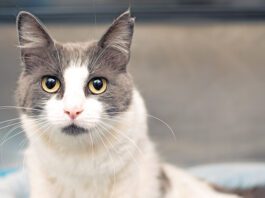The Odds of Deafness in White Cats
If you own a white cat, you most likely love his striking snowy coat and bright eyes. But you might also know that these brilliant features have implications that go deeper than appearance.
Ask Elizabeth: May 2017
About a year ago, he started to leave feces in non-litter box areas. While he still used the litter box, he would also leave feces right next to the box and also in an area by the front door.
Short Takes: April 2017
Hundreds of projects are underway across the U.S. and perhaps thousands worldwide using citizen scientists. Theyre volunteers who collect information, usually in cooperation with professional scientists, in fields from computer science to medicine, ecology, outer space and beyond. Rather than the big breakthrough, the results of scientific studies often can indicate whats ineffective in treatment. That was the case when Craig Webb, DVM, Ph.D., at Colorado State University led a clinical trial of a diabetes mellitus treatment.
Ticks Become a Full-time Menace to Cats
If you think your cat cant get ticks or the diseases that they spread, emerging evidence indicates otherwise. While cats, unlike dogs, are fairly resistant to tick-borne diseases, they can be affected, says Meredith L. Miller, DVM, ACVIM, a lecturer in small animal medicine at Cornell University College of Veterinary Medicine.
Ask Elizabeth: March 2017
My 2-year-old cat, who we took in as a stray after gradually gaining his trust about a year ago, has been having a problem that I wonder if you can help with. He has started to pull his fur out in small cotton ball-sized clumps. I find these clumps all over the house, and its driving me crazy. He is an indoor/outdoor cat and there are no other pets or kids in the house. Can you provide some insight?
An Anonymous Grant to Evaluate GI Diseases
A grant from anonymous donors in memory of their cat, Speckles, will support feline research to distinguish between gastrointestinal disease caused by inflammatory bowel disease (IBD) and lymphoma. The project will assess fecal bacteria and if significant difference is found, it may lead to a less invasive, more accurate diagnosis.
When to Seek Treatment for Constipation
Cats typically defecate one to three times a day, depending in part on the food they eat. Constipation - an inability to routinely and easily produce stool - is a fairly common feline disorder, says Meredith L. Miller, DVM, ACVIM, a lecturer in small animal medicine at Cornell University College of Veterinary Medicine.
Cat Scratch Fever Spikes in January
Hand-wrestling your kitten or newly adopted cat may seem like harmless play, but if either would happen to scratch you, you could develop an infection requiring treatment for cat scratch disease (CSD). This rare but potentially serious condition is estimated to affect about 12,500 people annually in the U.S., including 500 hospitalized for treatment. The incidence is higher than medical experts anticipated, according to a new study released by the Centers for Disease Control (CDC).
20 Inspirational Ideas for Cat Owners
At the close of each year, do you find yourself writing a list of ambitious resolutions to eat healthier and exercise more? Perhaps you decide to eat more kale and spend more time at yoga and less lounging on the couch. We often craft New Years resolutions with good intentions but rarely fully achieve them.
Considering Pet Sitting or Boarding?
Cats crave routine and seem to be in sync with your work schedule. But they know that the daily routine is about to be upended when they see you bring out the dreaded suitcase. Even though you look forward to a much-needed vacation, you may find yourself worrying about how your cat will fare during your absence.
Geography’s Role in Feline Ear Infections
Ear infections are relatively uncommon in cats - infections of the external ear occur twice as often in dogs. However, you should be aware of these significant facts: A study shows that geography can determine if your cat is likely to develop an ear infection. Left untreated, an infection can become chronic, causing pain and irreparable damage to the ear canal or eardrum. You can become the first line of defense in identifying an ear infection. Simply check your cats ears by giving them a quick rub - something you probably do everyday. Whether your cat shows pleasure or discomfort is a clue to the ears condition.
Claws Reveal Cats’ Health Status
Cats depend on their claws to grip while climbing. They serve as weapons in a fight, hold their prey and release scent to declare ownership of your sofa. While many cats are fastidious about grooming, indoor kitties depend on their owners to keep their claws in top shape. They dont do enough digging and scratching on abrasive objects to keep the claws short.
















